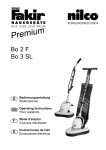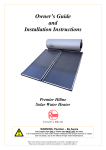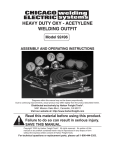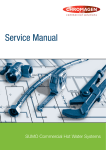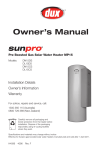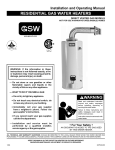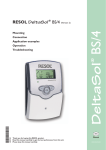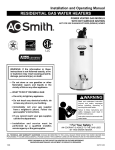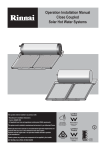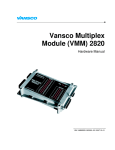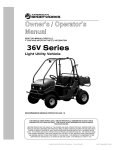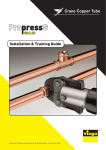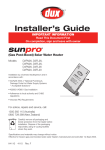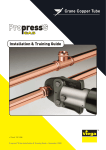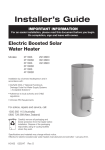Download Installation & User Manual
Transcript
Installation& User Manual Domestic Solar Hot Water Systems 1 Forced Circulation (Pumped) Open and Closed Loop Systems Thermosiphon Open and Closed Loop Systems Use of this Manual This manual contains easy to follow procedures for the correct installation and operation of CHROMAGEN Open and Closed Loop Thermosiphon and Pumped Solar systems. Please take your time to read and understand the operating guidelines provided to ensure successful and trouble-free operation of your Chromagen water heater. If you have any questions, contact your local CHROMAGEN customer service representative on 1300 367 565. 2 Index Installer to complete4 Glossary5 Chromagen the company6 Consumer information 6 Installation information 10 Maintenance and service calls 32 Electrical water heater information 33 Solar controller information 35 Warranty 36 3 Installer to Complete Installation Address Date of installation Approximate angle of collectors ( ) degrees East / West Of North Tank size ( )litres. Tank Type: Horizontal / Vertical And Open / Closed Loop Water pressure (incoming) kPa Note: Pressure limiting valve required if over 650kPa Electrical connection is Continuous/Off Peak, with Thermostat set at ( Gas Pressure (gas boost only) ( Flow valve set to ( )kPa Static ( )kPa loaded (all appliances running) )l/min (0.75 l/min for single panel, 1.75 l/min for multiple panels) Tempering valve operation tested and temperature adjusted to ( )degrees Celsius Warranty Manuals and documents given to customer Y/N System operation explained to customer Y/N All pipe-work insulated in line with AS/NZS 3500 and local requirements Y/N Frost valve (if fitted) operation explained to customer Y/N Installer Company Name Installer Name License Number Chromagen Pty Ltd For service, call: 1300 367 565 4 )degrees Celsius Contact Number Glossary Absorber Plate��������������������������������������� The part of the collector that collects the solar energy and transforms it to heat. Booster��������������������������������������������������� A supplementary heat source i.e. electricity, gas. Close Coupled Solar����������������������������� Where the solar storage tank and solar collectors are connected close together. Closed Loop������������������������������������������� Using a heat exchange fluid to heat the potable water via a heat exchanger. Differential Controller��������������������������� An electrical device that reads the difference between the Collector temperature and the stored water temperature to control the solar input. Element�������������������������������������������������� A thermostatically controlled booster element heats the stored water in conjunction with the available solar energy. Continuous Water Heater��������������������� A gas booster that only heats the water as it flows through it. Glycol (Heat Exchange Fluid)��������������� Transfers the solar energy to the stored potable water via a heat exchanger, prevents freezing or clogging of collectors in bad water areas. Non Return Valve����������������������������������� Also known as a check valve, allows liquid to flow in only one direction. Off Peak�������������������������������������������������� Electrical power supplied at a prearranged time. Thermosiphon Arrest Valve������������������ Ensures the thermosiphon system will not overheat. Pumped Solar System��������������������������� Utilises a pump to circulate the fluid from solar collectors to the storage tank. Pressure Limiting Valve������������������������ A valve connected to the cold water inlet to the water tank to control the water pressure. Pressure/Temperature Relief Valve����� A valve installed in the water tank to relieve excessive pressure and temperature. Potable Water���������������������������������������� Drinking water Selective Surface����������������������������������� The special treatment given to the surface of the absorber plate. Storage Tank������������������������������������������ A lined water tank for storing the heated water. Solar Collector��������������������������������������� Glazed flat-plate collector where the fluid passes through copper tubes and is heated by solar energy. Tempering valve������������������������������������ A valve used to control the delivery temperature of the stored water. Thermosiphon���������������������������������������� As fluid is heated it becomes less dense (lighter) and rises, as it becomes colder it becomes denser (heavier) and falls causing thermosiphoning. Thermostat��������������������������������������������� Automatically switches the booster on and off to maintain the temperature in the storage tank. 5 Chromagen the Company Chromagen has been manufacturing and installing solar water heaters throughout the world since 1962. Since then, we have developed a system of solar energy absorption, transfer and storage so advanced, that we are at the forefront of the solar water heating industry today. CHROMAGEN provides two basic configurations, in a range of sizes and models. Thermosiphon Closed Coupled Systems The traditional roof mounted thermosiphon solar hot water systems are available in 200 and 300 litre tank sizes with one, two, or three solar collectors. The solar system utilizes natural thermosiphon to maximize solar efficiency. In areas where there is the possibility of freezing, frost protection must be used. As the use of a ‘closed loop’ system may be required, always discuss your options with your local Chromagen expert. Split Pumped Systems When aesthetics are an important consideration, Chromagen’s range of pumped solar water heaters are installed with the storage tank mounted at ground level, with one, two or three solar collectors mounted onto the roof. Chromagen’s ‘smart’ solar controller monitors water temperature and uses available solar energy to ensure maximum solar savings. In areas where water is prone to freezing, closed loop systems or systems with evacuated tube collectors must be installed for frost protection. As the use of a ‘closed loop’ system may be required, always discuss your options with your local Chromagen expert. Consumer Information General information and operating guidelines for Chromagen Water Heaters The general performance and energy savings that you can expect from your Chromagen water heater will depend upon a number of factors, such as water usage patterns, daily temperatures, available solar energy and the cost and type of purchased energy being utilized. Your Chromagen water heater is designed to utilize a combination of solar energy and purchased energy, operating simultaneously, to maintain a minimum operating temperature of 60°C. To ensure that you always have an adequate supply of hot water, we recommend that the auxiliary booster is left switched ON at all times. The automatic thermostat will switch the auxiliary booster on and off automatically. Reliance on ‘solar energy only’, or minimizing auxiliary booster usage manually to unrealistic times, can and will result in inadequate water temperatures, particularly during times of cool and inclement weather. Overnight temperature stabilization results in a reduction in water temperature, as the hot water at the top of the storage cylinder transfers some of its heat to the cooler water in the lower part of the cylinder. This effect is often perceived as ‘heat loss’ by consumers who control their boosting to minimal times. Utilizing the auxiliary booster as recommended will ensure that the effects of overnight temperature stabilization have no effect on the water temperature in the home. 6 To ensure adequate hot water is available at all times, it is important to follow our simple operating guidelines. Standards and Regulatory Requirements All Chromagen solar hot water systems must be installed by an authorized plumber. All installation work must meet local authority standards, Australian Standard (AS/NZS 3500.4) and the National Plumbing Code along with local electrical regulations. Where required, the relevant electrical and plumbing work will need to be certified to the satisfaction of local regulatory authorities. Solar Hot Water Storage Tank To obtain maximum performance the solar tank/system should be positioned as close as possible to the most used outlets. The solar pumped storage tank can be installed internally (dependant upon local regulations) on an approved spill tray with drain or externally, on a level concrete plinth. Boosting Average annual solar savings are calculated with the ‘auxiliary booster’ left in the ‘ON’ position at all times. It is important to understand that the system is not always consuming purchased energy when the ‘booster’ is on, as the system regulates purchased energy use via an inbuilt automatic thermostat. It is not necessary for consumers to manually turn the ‘booster’ switch on / off. If your system is operating on a solar / electricity combination, Chromagen recommend that the electrical booster is connected to standard ‘Day Rate’ electricity to ensure an adequate supply of hot water at all times. To maximize the amount of solar savings available, a time clock can be fitted to supply electricity to the booster at selected times. Systems that use electrical boosting can be connected where available to “Off Peak” power, however to ensure that adequate hot water is available at all times a ‘Day Rate’ facility will need to be provided. If your system is operating on a solar / gas combination, utilizing a continuous flow gas water heater as the auxiliary booster, the gas water heater will need to be left with the power and gas switched ‘ON’ at all times. For operating and maintenance information, please refer to the separate gas manual provided. When using gas boosting through a continuous hot water system, the gas system should be as close as possible to the most used outlets. Solar systems can also be used for pre-heating to an existing hot water heater provided that – || The existing water heater is thermostatically controlled, not flow controlled. || The operating pressure of the two systems is compatible. || The existing water heater is able to provide adequate hot water supplies during times of cooler or inclement weather. || The warranty or lifespan of the existing water heater is not affected by the installation of a solar water heater as a pre heater. || The electric element is removed from the solar water heater. 7 Hot Water can be DANGEROUS WARNING HOT WATER BURNS. As a safety precaution, young children should always be supervised around hot water fixtures. Hot water systems can store water at temperatures that can cause scalding. Water temperatures over 50°C can scald and care needs to be taken to ensure that injuries do not occur through incorrect use of your water heater. As solar water heaters can generate water temperatures in excess of 85°C, regulations require that a solar rated tempering valve be fitted to the heater to prevent water temperatures going to the home exceeding a preset safe maximum. The tempering valve must be connected to the hot water outlet line from the solar system. The valve must be fitted by an authorized plumber at the time of installation or in retrofitting to existing systems. Care should be taken to avoid coming into contact with any pipe work or fixtures associated with the water heater collector flow and return lines. Water from the solar collectors can be hot enough to create pressurized steam which can cause severe scalding - Under NO circumstances should any ‘home handy man’ type modifications be attempted. || Appliance not intended for use by persons (including children) with reduced physical sensory or mental capabilities, or lack of experience and knowledge, that prevents them from using the appliance safely without supervision or instruction. || Children playing with the appliance. Children should be supervised by a responsible adult for their safety to ensure that they do not play with the appliance. || DANGER: Failure to operate the relief valve easing gear at least once every six months may result in the water heater exploding. Continuous leakage of water from the valve may indicate a problem with the water heater. || THE INSTALLATION MUST COMPLY WITH THE REQUIREMENTS OF AS/NZS 3500, AS/NZS 3000, and all local codes and regulatory authority requirements. In New Zealand, the installation must conform to the New Zealand Building Code G12. || The power supply must be protected by an individual circuit breaker at the main electrical supply switchboard and rated to suit the booster size. The supply to the solar water heater can be operated directly from the switchboard or via a remotely mounted switch or time clock as requested by the customer. The heater must be provided with a suitable means for disconnecting the power supply. How hot will the stored water be? As a general rule of thumb, a correctly selected solar water heater can attain an average of twice the ambient day time temperature from solar energy alone. In simple terms, on a clear cloudless day of 25°C, solar energy will raise the stored water to roughly 50°C. The auxiliary booster will then boost the water to 60°C During the warmer months, where daytime temperatures can exceed 40°C, temperatures can exceed 85°C. As thermosiphon systems have no ability to control temperature gained from solar input, we recommend the use of a ‘thermosiphon arrestor valve’ in areas subject to high solar energy conditions in instances where more than one solar collector is installed, as the stored water can be heated to very high temperatures. Temperatures exceeding 95°C can result in the temperature relief valve activating, which can result in large volumes of wasted water. Chromagen’s range of split pumped systems utilize a solar controller designed to automatically cease circulating water through the solar collector array once the stored water has reached a maximum of 85°C. It is important to ensure that the power supply to the pump control unit is NEVER switched off during normal ‘day to day’ operation. 8 Frost Protection Chromagen ‘Open Loop’ split pumped systems are not suitable for installation where the ambient temperature falls below 4°C and/or above 800 meters altitude without additional frost protection – systems installed under these conditions suffering frost damage, will not be covered under Chromagen’s warranty program. Chromagen Evacuated Tubes or closed loop systems are recommended for these sites. Chromagen recommend the use of ‘Closed Loop’ (Thermosiphon or Vertical) systems in areas of known frost. Thermosiphon Open loop Systems exposed to infrequent frost conditions must be installed with one Frost protection valve per panel If a Chromagen ‘Open Loop’ split pumped system is to be installed in an area subject to freeze conditions, an approved freeze protection valve MUST be fitted to protect against frost damage. Where more than 1 panel is installed a freeze protection valve should be installed on each panel. Systems not fitted with an approved freeze protection valve suffering frost damage will not be covered under Chromagen’s warranty program. Chromagen’s range of ‘Open Loop’ split systems are fitted with an inbuilt frost protection mechanism in the solar control unit designed to automatically circulate a small amount of water through the solar collector array when freeze conditions occur. It is important to ensure that the power supply to the pump control unit is NEVER switched off during normal day to day operation. If you are unsure about the level of frost protection required in your area please contact your Chromagen solar specialist on 1300 367 565 Chromagen’s warranty will not apply to frost damage collectors if the pump and or controller are determined to be faulty for any reason, including power failure except within the first 12 months. It is the home owner’s responsibility to check the system before winter to determine that the system is circulating water to the collectors. This can be done by checking temperature of the pressure relief valve on a sunny day in the late afternoon. If the valve is hot the pump and controller are working properly and this verifies that the frost protection will function correctly. Failing to perform this check will render the home owner liable for the full expense of collector replacement should frost damage result. Going away on holidays? If the water heater is left unused for two weeks or more, a small quantity of hydrogen gas (which is highly flammable) may accumulate in the top of the water cylinder. To dissipate this gas safely it is recommended that a sink or bath hot tap be turned on to dispel a couple of litres of water. During this procedure there should be no smoking, open flames or any electrical appliances such as washing machines or dish washers operating nearby. If hydrogen is discharged through the tap, it will make a sound like air escaping. 9 Installation Information Water Quality Town water supplies are generally a controlled water source and should not cause any difficulty with the system. Some water may have elevated mineral content and require more frequent system maintenance. Chromagen ‘Open Loop’ systems are suitable for use with water supplies with a total dissolved solid content less than 1000 ppm and in which the total hardness does not exceed 200 ppm CaCO3. If the local water supplies have calcium hardness (CaCO3) exceeding 200 ppm, and an alkalinity in excess of 150 ppm, then a Chromagen ‘Closed Loop’ system should be selected. Your local water supply authority can supply a water analysis if required, or simply contact Chromagen’s Customer Services on 1300 367 565. Water Pressure The storage tank has a pressure/temperature relief valve set at 1,000 kPa. The cold water inlet pressure should not exceed 800 kPa (approximately 20% below the pressure relief valve setting). A pressure reduction valve must be installed if this is not the case. The relief valve will discharge a small amount of water when the system is heating and should be checked every six months WARNING Any checks of the PTR should be performed when the tank is cold to prevent exposure to scalding hot water. Please note: It is important to remember that when a pressure limiting valve (PLV) is also fitted, that the cold water line to the tempering valve is run ‘after’ the PLV to ensure that there is equal pressure from both the hot and cold water lines going to the tempering valve. Selecting System Location The collectors should be installed facing the equator. South in the Northern Hemisphere, North in the Southern Hemisphere (systems should face North in Australia). A deviation of 45° to east or west has little effect on annual solar gain. The solar collector should be no more than 15 metres away from the storage tank (in pumped systems). The collector/s must be at a minimum pitch of 10°, with flat roof frames available if less than 10° roof pitch. 30° pitch and over requires extra fixings and frames. The solar system should be free from shade all year round and clear from obstructions. Roof Support Requirements No extra roof supports are needed when installing a Chromagen pumped system in most cases, as a collector when full weighs between 32 kg and 51 kg and covers an area of between 1.7 and 2.8 square meters depending on the model. The collectors sit flat on the pitch of the roof. Chromagen’s thermosiphon systems can weigh in excess of 500kg and therefore the structural strength of the roof should be ascertained and its ability to support the weight prior to installation. When installed in cyclonic areas, the use of an approved Chromagen cyclone frame will be required. If you have any queries regarding the requirements of your location please contact your local Chromagen Customer Services representative on 1300 367 565. For installation instructions, please refer to the instructional leaflet provided with the frame. Electric Connections Local codes must be adhered to for all electrical work and be undertaken by a qualified electrician. Both thermosiphon and split pumped systems will need the element connected for auxiliary boosting (see data plate for power rating on hot water tank). All pumped solar hot water systems require a general power outlet to run the pump. When using a gas booster an additional general power outlet will be needed. Safety Solar hot water systems can be heavy so always use approved lifting devices when installing solar systems at heights. All Occupational Health and Safety issues must be adhered to. 10 Installation of Pumped Solar Systems Installing the Collectors WARNING Solar collectors can generate temperatures that can scald. Exercise extreme care when handling systems, paying special attention to the inlet and outlet fittings. Chromagen advise covering the solar collector during installation. WARNING If solar collectors are not connected to the solar storage tank for extended periods (eg; on new home installations) it is important to ensure that collector flow and return lines are emptied of water after pressure testing has been completed. Failure to drain flow and return lines can lead to dangerous, scalding water temperatures being released during tank ‘fit off’, or damage to collectors due to over pressurization. After selecting the position of the tank and collectors (making sure they are generally no more than 15 metres apart), check the roof for broken or loose tiles and rusted or loose steel sheets and make good. Position the collector rail on the front edge of a tile or over a batten and with the straps supplied, fix them to/ through the roof. Tilt the collector rail slightly on the hot outlet side to allow any air to be bled from the highest point. Before lifting the collector/s onto the roof, we recommend you install all brass fittings to the collectors. Due to the high temperatures generated, the use of standard Teflon is unsuitable. Only use a jointing system that is rated for high temperatures i.e. Hemp and TOT thread sealant, used with Loctite 569 (Hydraulic Sealant), Loctite 55 pipe sealing cord, or Loxeal. It’s the installers responsibility to ensure the appropriate sealant is used. Solar Collector Connections TWO/THREE COLLECTORS Fit a ¾ MI x ½ inch Conetite union on the cold water flow inlet fitting (bottom of collector). Fit ¾ MI inch brass plug in opposite fitting on collector array (non frost areas) Fit ¾ MI x ½ inch hex nipple and frost valve in opposite fitting on collector array (frost areas) Fit a ¾ MI x ½ inch Conetite union on the hot water return outlet fitting (top of collector opposite side to cold) Fit the ¾ MI x ½ FI inch reducing bush into the opposite fitting on the collector array Fit the ½ inch brass sensor fitting into the brass bush. Using the brass barrel unions connect the collectors together (if more than 1 collector). In areas of frost, a frost protection valve will need to be connected to the collector array. Ask your Chromagen solar specialist on 1300 367 565 when you need to include these valves. The connection of the solar flow and return lines must be diagonal to each other with the flow in the bottom and the return from the top on the opposite side. Connecting the Collectors Position the collector/s on the collector rail and tighten the collector barrel unions. Fix the collector/s onto the collector rail using the screws supplied. Attach the top collector strap and fix to through roof. Solar Flow and Return Lines Run the solar flow and return lines from collector/s to tank using insulated copper with a gradual fall to the storage tank. Approved flashing must be used when penetrating the roof. WARNING Under no circumstances should plastic piping be used. 11 Sensor Wire The solar sensor wire will need to be run with the flow and return lines from collectors to tank. Make sure the sensor wire is inserted into the sensor fitting and sealed. Make sure the sensor wire is protected from damage. If this wire is cut or broken it will need to be rejoined, soldered and shrink sealed. Ensure the sensor wire does not come into contact with the collector or tank flow and return line, as very high temperatures can interfere with the sensor wire and cause the solar controller to malfunction. Care should be taken to ensure that the sensor wire is protected from damage by external fixtures. The use of protective conduit is advised for all external areas. Solar Tank Connections (see system diagrams page) Position The solar tank will need to be positioned on an approved base i.e. a concrete plinth and as close as possible to the most used outlet or the gas booster if used. Base should provide ventilation, such as ripple plinth on polyslab to prevent water retention Solar Tank Connection Flow / Return. Please refer to the system diagrams on page (16-27) for the correct installation. Solar Differential Controller Installation || The controller must be fixed to the storage tank or the wall close to the tank using the fixing lugs || Fit the tank sensor fitting between the tank and controller || Connect the collector sensor wire to the fitting provided on the bottom of the controller || Plug the pump into the power outlet under the controller || Plug the controller into the GPO || Once tank is full of water, turn GPO on Hot and Cold Water Connections All plumbing connections must be done by a licensed plumber and in accordance with local authority regulations. Cold Water Connection The cold water inlet connection to the solar storage tank is ¾ inch FI. The cold water inlet requires an approved isolating non return valve. In some locations regulations require a pressure relief valve be fitted to the cold water supply. Hot water connection The hot water outlet from the solar tank is ¾ inch FI. All hot water pipes must be insulated. Installations on Flat Roof Stands Flat roof stands are available for systems where the pitch of the roof is below 10°. Please refer to the separate roof stand information sheet. Filling and commissioning the solar system 12 1. Turn on the cold water supply to the tank and open a hot water tap 2. Turn on the solar controller 3. DO NOT TURN ON THE GAS BOOSTER 4. Wait till water starts to come out for the hot water tap 5. Leave water running until air is bled, then turn off the hot water tap, 6. Switch on the power and the gas supply to the gas booster 7. Turn on the hot water tap inside the house to check if the booster is working and test the water temperature. CAUTION Ensure the storage tank is completely full of water by bleeding the hot water lines via an internal hot water tap (not the PTR Valve) before switching power on to the electrical element or plugging in and operating the continuous flow gas water heater. Failure to properly bleed the storage tank can in some cases cause damage not covered by Chromagen’s warranty policy. Open Loop Commissioning Procedure (See diagram page 16) Turn on the mains cold water to the storage tank making sure there is a hot tap turned on in the home to bleed all the air from the tank. When water begins to flow from the open tap, turn off. When tank full, manually turn solar pump on to remove any air in solar collectors. Re-open internal hot water tap to ensure all air is purged from the storage tank, then turn tap off. Once system is fully bled, plug in and turn on the solar controller. Closed Loop Commissioning Procedure (See diagram page 17 and 23) 1. (Turn on the mains cold water to the system making sure the pressure / temperature valve is open. When water flows from the pressure / temperature valve, close valve. Turn on a hot tap in the home to bleed all remaining air from the tank and the hot water lines. Check storage tank for leakage by pressure testing all fittings to a minimum of 800 kPa. Once any leaks are rectified, the system is ready for use. 2. Before introducing glycol to the system, ensure the solar collector is cold or well covered. 3. Before introducing glycol to the system, loosen the Male Iron (MI) union that connects to ball valve #4, to allow air to escape while filling the system. This will allow you to detect when the system is full. 4. Introduce glycol into the closed loop system by filling a bucket with the glycol supplied in your kit. Connect the bucket containing glycol to the ball valve (#5). Ensure that ball valve #4 is in the closed position. Then using a hand pump charge the system with glycol. When the glycol is finished in the bucket, add water to the bucket and continue to charge the system as necessary. 5. When all air is expelled from the system, and the water that is discharged from the Male Iron union is clear of bubbles, the system is fully charged. Tighten the Male Iron union to seal. 6. Open ball valve #4 7. Close ball valve #5 8. Disconnect the hand pump 9. To prevent damage or injury ensure the handles of both ball valves #4 & 5 are removed and the brass plug (#6) is fully sealed. 10.Plug the circulation pump in to the power socket underneath the controller (#2). Plug the controller and continuous flow gas water heater into the GPO. 11.If necessary uncover the solar collector. WARNING The closed circuit fluid operates at both high temperature and pressure. Inadvertent opening of the circuit by householders could lead to severe injury. Once the closed circuit is fully charged with the glycol solution and the circuit has been sealed by closing the ball valve located at the storage tank, remove handle from ball valve and seal off with brass fitting supplied. 13 Installation of Thermosiphon Systems (Open and Closed) After selecting the position of the system, check the roof for broken or loose tiles and rusted or loose steel sheets and make good. The roof needs to be able to hold the weight of the solar system (up to 500kg). Measure down the required distance (which varies with different collectors) from where the front leg of the tank will be positioned. It needs to be located on the front edge of a tile for support via the tile batten below, or over the roof batten on a steel roof. Using the collector rail straps fix them to the roof rafter by running them between the tiles or screwed through the roof into a batten on a steel roof. Tilt the collector rail up slightly (10mm) on the collector hot return side to ensure thermosiphon occurs. Before lifting the collector/s onto the roof, fit the connecting barrel unions to the collectors. Due to the high temperatures the use of standard Teflon is unsuitable. Only use a jointing system that is rated for high temperatures .i.e. Hemp and TOT thread sealant, used with Loctite 569 (Hydraulic Sealant), Loctite 55 pipe sealing cord, or Loxeal. It’s the installers responsibility to ensure the appropriate sealant is used. Lift the collector/s into position and connect together. Fix the collectors to the collector rail using the screws supplied. Lift the storage tank into position and centralize it on the top of the collectors, fixing the rear tank straps to the roof rafters/battens. Using the connecting fittings and pipes, connect the tank and collector/s together. (See system diagram page 26-27). For closed loop systems the installation of an expansion tank and bleed/fill valve is needed. In areas of frost, freeze protection valves can be connected to the collector array on the side opposite to the cold water flow line, via a ¾ x ½ inch brass hex nipple in place of the bottom collector plug. Ask your Chromagen solar specialist when you need to include these valves. Multiple panels may require additional valves Filling and commissioning Open Loop WARNING Do not turn power on to the electrical element until the following procedure is undertaken. Turn on the mains cold water to the system making sure the pressure / temperature relief valve is open. When water flows from the pressure / temperature relief valve, close valve. Turn on a hot tap in the home to bleed all remaining air from the tank and the hot water lines. Check system for leakage by pressure testing all fittings to a minimum of 800 kPa. Once any/all leaks are rectified, the system is ready for use. Closed Loop Tank Turn on the mains cold water to the system making sure the pressure / temperature valve is open. When water flows from the pressure / temperature relief valve, close valve. Turn on a hot tap in the home to bleed all remaining air from the tank and the hot water lines. Check storage tank for leakage by pressure testing all fittings to a minimum of 800 kPa. Once any/all leaks are rectified, the system is ready for use. Jacket and Collectors 14 || Connect a half inch hose to the fill valve located at the bottom right hand corner of the solar collector || Ensure that the test fitting located on the top of the tank is ‘unplugged’ || Fill the collectors and tank jacket with potable water via the fill valve located at the bottom of the collector/s until water flows from the test fitting located on the top of the tank making sure to bleed all air from the jacket || Close fill valve and fit test fitting brass plug || Check all connections for leaks by pressurizing the system to 500 kPa || After testing the system, release the pressure from the jacket and introduce the antifreeze via the fill valve located at the bottom of the collectors || Once full, close the fill valve and plug both the test fitting and the fill valve. The system should be now free from air and ready for use Propylene Glycol Glycol should be added at a ratio of 35-60% of the volume depending on the local climate. Chromagen’s Glycol solution is blue in colour. Although unlikely, if the water from your closed loop water heater appears blue, then this may indicate a leak of the fluid from the heat exchanger into the stored hot water. Chromagen Glycol is a food-grade fluid, and does not present a health hazard. However, the blue colour in the water indicates that a service call is required, and your local Chromagen service office should be contacted. Call 1300 367 565. WARNING Although non toxic, Propylene Glycol MUST NOT be allowed to enter rain water storage tanks. Installation of collector / tank rails For collector mounting frame to colorbond roofing; 1. Remove screws along batten line where panel rail is to be fastened 2. Mark hole locations and pre-drill collector mounting rail 3. Place rubber washers between collector mounting rail and roof surface at each hole 4. Reattach roofing screws through collector rail into existing screw holes of roof sheeting 5. Fasten collector to mounting rail For collector mounting frame to tiled roofing; 1. Locate trusses and remove tiles above mounting points 2. Fold stainless steel strap in half and pass through vent slots on base in line with trusses 3. Secure a minimum of 3 screws through both sides of strap and into top chord of truss 4. Replace tiles 5. Fasten collector to mounting rail For thermosiphon frame on colorbond roofing; 1. Remove screws along batten line where tank strap is to be fastened 2. Fold stainless steel strap in half and pass through tank mounting brackets in line with existing screw holes 3. Place rubber washers between tank mounting strap and roof surface at each hole 4. Reattach roofing screws through mounting strap into existing screw holes of roof sheeting For thermosiphon frame on tiled roofing; 1. Locate trusses and remove tiles above mounting points 2. Fold stainless steel strap in half and pass through tank mounting brackets in line with trusses 3. Secure a minimum of 3 screws through both sides of strap and into top chord of truss 4. Replace tiles 15 Installation Diagram of Pumped Open Loop System 2 1 4 6 Continuous Flow Gas water heater for Gas boosted systems only 7 2 5 1 5 Part 3 11 1 2 3 4 5 6 12 8 7 950 8 620 10 9 460 7 170 8 TO BE SUPPLIED BY INSTALLER 8 9 10 11 12 Collector Connecting KIT Collector union Connection union Cold flow line Sensor fitting (Collector) Brass plug/frost valve Hot return line Sensor wire (18m extension lead) NON return valve Pressure limiting valve Duo valve Tempering valve PTR valve 6 1 5 4 Part Tank Connecting KIT 7 3 16 2 Part# 1 Solar controller P0010 2 Solar pump P0202 3 Sensor fitting P0463 4 Flow control valve P0483 5 Solar flow to collectors 6 Solar return from collectors 7 Cold supply to tank (800kPa max) Part# P0044 P0040 P0070 K0025 P0200 P0086 P0201 P0087 P0077 P0015 Installation Diagram of Pumped Closed Loop System 1 5 2 7 6 3 2 1 HOT OUTLET Part 10 1 2 3 4 5 6 7 8 9 10 11 PTR VALVE 8 4 9 Collector Connecting KIT Part# Collector union Connection union Cold flow line Brass plug Sensor fitting (Collector) Hot return line Sensor wire (18m extension lead) Pressure limiting valve Duo valve Tempering valve NON return valve P0044 P0040 P0029 P0463 P0151 P0201 P0087 P0077 P0086 11 TO BE SUPPLIED BY INSTALLER 1 5 4 10 6 3 2 Part 1 3 1 7 3 1 8 9 1 2 3 4 5 6 7 8 9 10 Tank Connecting KIT Part# Hex nipple Solar controller Brass tee Bleed valve Fill valve Brass plug MI x C union Solar pump Sensor fitting Expansion tank P0028 P0010 P0027 P0078 P0078 P0029 P0025 P0202 P0463 P0019 WARNING The closed circuit fluid operates at both high temperature and pressure. Inadvertent opening of the circuit by householders could lead to severe injury. Once the closed circuit is fully charged with the Glycol solution and the circuit has been sealed by closing the ball valve located at the storage tank, remove handle from ball valve and seal off with brass fitting supplied. DO NOT FILL GLYCOL WHILE THE PANELS ARE HOT - COVER THE PANELS WELL BEFORE FILLING GLYCOL. After commissioning fit pump cover 17 Smart Line 200 Litre Gas - Solar Open Loop System I A G Specifications F E D C B A 1260mm Hot water outlet B 100mm Cold water inlet C 460mm Collector cold flow line D 620mm Collector hot return line E 950mm Pressure/Temperature Valve F 1255mm 20mm Gas line G 1870mm Height H 600mm Width I 1810mm Flue Terminal 95 Kilograms (empty) Weight H Filling and commissioning the solar system 1. DO NOT TURN ON THE GAS BOOSTER UNTIL SYSTEM IS FULL 2. Connect the various water pipes as per the adjoining diagram 3. Open a hot water tap in the house and turn on the cold water supply to the tank 4. Wait until water starts to come out of the hot water tap 5. Leave cold water running until air is bled, then turn off the hot water tap in the house 6. After no further air can be detected, plug the pump power lead into the solar controller 7. Connect the solar controller to GPO DOUBLE Check that all air has been purged from the system 8. Loosen the nut immediately before the non return valve on the collector return line 9. Allow water to flow until no further air is detected. 10.Re-tighten 11.Switch the nut and check for leaks on the power and the gas supply to the gas booster 12.Turn on the hot water tap inside the house to check if the booster is working and test the water temperature. 13.After 18 commissioning fit pump cover Smart Line 200 Litre Gas - Solar Open Loop System 1 2 3 11 12 Part Collector Connecting KIT Part# 1 Sensor fitting (Collector) P0463 2 Sensor wire (18m extension lead) P0151 3 Cold flow line 4 Duo valve (to be supplied by installer) P0087 5 Pressure limiting valve (to be supplied by installer) P0201 6 Hot outlet 7 Hot return line 8 Tempering valve (to be supplied by installer) P0077 9 Non return valve P0086 10 PTR valve P0015 11 Gas supply 12 Brass plug / frost valve 8 6 10 7 9 4 9 9 5 K0025 6 4 86 1 1 4 5 5 3 Part Tank Connecting KIT 4 Part# 1 Solar controller P0010 2 Solar pump P0202 3 Sensor fitting P0463 4 Flow control valve P0483 5 Solar flow to collectors 6 Solar return from collectors 7 Cold supply to tank (800kPa max) 3 7 7 2 2 19 Solar Easy 200 Litre Gas - Solar Open Loop System I A G Specifications F E D C B A 1260mm Hot water outlet B 100mm Cold water inlet C 460mm Collector cold flow line D 620mm Collector hot return line E 950mm Pressure/temperature valve F 1255mm 20mm gas line G 1870mm Height H 600mm Width I 1810mm Flue terminal 95 Kilograms (empty) Weight H Filling and commissioning the solar system 1. Position the tank with connections on the left hand 2. Pop rivet (x 4) the top box to the tank 3. Fix the top box to the wall 4. Assemble the pump and other fittings as indicated in adjoining photo 5. Connect the tank to booster hose (650mm) 6. Connect solar flow to collectors 7. Connect solar return at tank 8. Connect cold water inlet and hot outlet 9. Connect gas 10.Fill tank and test 11.Connect tank sensor white wire into sensor plug with silicon 12.Connect collector lead into black adaptor from box DOUBLE Check that all air has been purged from the system 13.Turn on hot water tap in the house to ensure all air has been purged from the system 14.Switch on the power and the gas supply to the gas booster 15.Commission 16.The system is ready for use 17.After 20 the solar and gas booster commissioning fit pump cover Solar Easy 200 Litre Gas - Solar Open Loop System 1 2 3 11 12 8 Part Collector Connecting KIT 1 Part# Sensor fitting P0463 P0151 2 Sensor wire 3 Cold flow line 4 Duo valve (to be supplied by installer) P0087 5 Pressure limiting valve (To be supplied by installer) P0201 6 Hot outlet 7 Hot return line 8 Tempering valve (to be supplied by installer) P0077 9 Non return valve P0086 10 PTR valve P0015 11 Gas supply 12 Brass plug / frost valve 6 10 7 9 4 9 9 5 K0025 6 1 5 4 Part Tank Connecting KIT Part# 1 Solar controller P0010 2 Solar pump P0202 3 Sensor fitting P0463 4 Flow control valve P0483 5 Solar flow to collectors 6 Solar return from collectors 7 Cold supply to tank (800kPa max) 7 3 2 21 Smart Line 200 Litre Gas - Solar Closed Loop System I A G F E D C Specifications A 1260mm Hot water outlet B 180mm Collector cold flow line C 290mm Cold water inlet D 715mm Collector hot return line E 945mm Pressure/Temperature Valve F 1255mm 20mm Gas line G 1870mm Height H 600mm Width I 1810mm Flue Terminal 95 Kilograms (empty) Weight B H Filling and commissioning the solar system 1. (Turn on the mains cold water to the system making sure the pressure / temperature valve is open. When water flows from the pressure / temperature valve, close valve. Turn on a hot tap in the home to bleed all remaining air from the tank and the hot water lines. Check storage tank for leakage by pressure testing all fittings to a minimum of 800 kPa. Once any leaks are rectified, the system is ready for use. 2. Before introducing glycol to the system, ensure the solar collector is cold or well covered. 3. Before introducing glycol to the system, loosen the Male Iron (MI) union that connects to ball valve #4, to allow air to escape while filling the system. This will allow you to detect when the system is full. 4. Introduce glycol into the closed loop system by filling a bucket with the glycol supplied in your kit. Connect the bucket containing glycol to the ball valve (#5). Ensure that ball valve #4 is in the closed position. Then using a hand pump charge the system with glycol. When the glycol is finished in the bucket, add water to the bucket and continue to charge the system as necessary. 5. When all air is expelled from the system, and the water that is discharged from the Male Iron union is clear of bubbles, the system is fully charged. Tighten the Male Iron union to seal. 6. Open ball valve #4 7. Close ball valve #5 8. Disconnect the hand pump 9. To prevent damage or injury ensure the handles of both ball valves #4 & 5 are removed and the brass plug (#6) is fully sealed. 10.Plug the circulation pump in to the power socket underneath the controller (#2). Plug the controller and continuous flow gas water heater into the GPO. 11.If necessary uncover the solar collector. 12.After commissioning fit pump cover DOUBLE Check that all air has been purged from the system Glycol should be added at a ratio of 35-60% of the volume depending on the local climate. 22 1 2 3 11 12 8 6 Collector Connecting Kit Part# 1 Sensor fitting P0463 2 Sensor wire P0070 3 Cold flow line Part 4 Duo valve P0087 5 Pressure limiting valve (to be supplied by installer) P0201 6 Hot outlet 7 Hot return line 10 7 13 8 Tempering valve P0077 9 Non return valve P0086 10 PTR valve P0015 11 Gas supply 12 Brass plug P0046 13 Expansion tank P0019 14 Solar pump P0202 2 14 4 9 5 1 Tank Part Connecting KIT Part# 1 Hex nipple P0028 2 Solar controller P0010 3 Brass tee P0027 4 Bleed valve P0078 5 Fill valve P0078 6 Brass plug P0029 7 MI x C union P0025 8 Solar pump P0202 9 Sensor fitting P0463 10 Expansion tank P0019 5 4 10 6 3 2 1 3 1 7 3 1 9 8 WARNING The closed circuit fluid operates at both high temperature and pressure. Inadvertent opening of the circuit by householders could lead to severe injury. Once the closed circuit is fully charged with the Glycol solution and the circuit has been sealed by closing the ball valve located at the storage tank, remove handle from ball valve and seal off with brass fitting supplied. DO NOT FILL GLYCOL WHILE THE PANELS ARE HOT - COVER THE PANELS WELL BEFORE FILLING GLYCOL 23 Chromagen 400 Litre SplitLine Gas / Electric - Solar Open Loop System A Specifications A 650mm Tank width B 1765mm Tank height C 271mm Cold water inlet D 1466mm Hot water outlet E 630mm Collector hot return F 271mm Collector cold flow G 450mm Sensor Point H 1466mm PTR valve Weight 126kg Weight (empty) B H D E G C F Filling and commissioning the solar system 1. DO NOT TURN ON THE GAS BOOSTER UNTIL SYSTEM IS FULL 2. Connect the various water pipes as per the adjoining diagram 3. Open a hot water tap in the house and turn on the cold water supply to the tank 4. Wait until water starts to come out of the hot water tap 5. Leave cold water running until air is bled, then turn off the hot water tap in the house 6. After no further air can be detected, plug the pump power lead into the solar controller 7. Connect the solar controller to GPO DOUBLE Check that all air has been purged from the system 8. Loosen the nut immediately before the non return valve on the collector return line 9. Allow water to flow until no further air is detected. 10.Re-tighten 11.Switch the nut and check for leaks on the power and the gas supply to the gas booster 12.Turn on the hot water tap inside the house to check if the booster is working and test the water temperature. 13.After 24 commissioning fit pump cover Thermostat An adjustable thermostat is fitted and preset to 60°C. This can be adjusted to suit individual requirements Thermostat wiring || Wiring penetration should be made through the supplied grommet at the base of the thermostat cover || Wiring must be performed by a competent licensed electrician in accordance with all relevant standards || Wiring between element and thermostat is run through internal conduit between the 2 areas || Temperature calibration should be tested at time of commissioning. WARNING All Electrical Connections must be made by a licensed Electrician 1 4 Thermostat (Electric boosted systems only) 2 7 6 2 5 1 5 3 Continuous Flow Gas water heater (Gas boosted systems only) 8 10 15 10 14 9 TO BE SUPPLIED BY INSTALLER 13 10 12 11 Part System Parts Description Part# 1 Collector union P0044 2 Connection union P0040 3 Cold flow line 4 Collector sensor fitting P0070 5 Brass plug / frost valve K0025 6 Collector return line 7 Collector sensor cable (18m extensionlead) P0200 8 Solar controller P0010 9 Solar pump P0202 10 Non return valve P0086 11 Cold supply to tank (500 kPa max) 12 Duo valve (supplied by installer) P0087 13 Pressure reducing valve (500 kPa) P0201 14 Tempering valve (supplied by installer) P0077 15 Flow control valve P0483 25 Chromagen RoofLine (Thermosiphon) Open Loop System Read individual instructions included with each system. 3 2 4 5 1 61 STORAGE TANK TEMPERED WATER SUPPLY 7 COLD WATER SUPPLY 8 9 1 12 10 11 SOLAR COLLECTOR Part Connecting KIT 1 Duo valve if required supplied by installer 2 Pressure limiting valve if required (supplied by installer) 3 Tempering valve (supplied by installer) 4 Non return valve 5 PTR valve 6 20mm collector union 7 Hot return line (Collector to Tank) 8 Thermosiphon arrestor valve 9 20mm brass plug 10 Cold Flow Line (Tank to Collector) 11 Anti frost valve connection kit (if Required) 12 20mm brass plug or Anti frost valve connection kit (if required) THERMOSIPHON ARRESTOR VALVE OPERATION The thermosiphon arrestor valve (TA20) is fitted to a thermosiphon solar hot water system to limit the water temperature in the storage cylinder to approximately 80°C. The valve is located at the cold return to the collectors and closes automatically when the water from the bottom of the storage cylinder, passing through the valve, reaches 60°C - 65°C. This prevents any further thermosiphon action from taking place until the temperature in the storage cylinder reduces. When the water temperature in the storage cylinder reduces (cools) the valve opens automatically, allowing the syphon action to resume. To collector Max Temperature: Max Pressure: Activation Temperature: 26 Cylinder 99°C 1400kPa. 60°C - 65°C Chromagen RoofLine (Thermosiphon) Jacketed tank System Read individual instructions included with each system. 3 2 4 1 STORAGE TANK 5 TEMPERED WATER SUPPLY 61 COLD WATER SUPPLY 7 8 12 9 10 11 9 10 SOLAR COLLECTOR Part Connecting KIT 1 Duo valve if required supplied by installer 2 Pressure limiting valve if required (supplied by installer) 3 Tempering valve (supplied by installer) 4 PTR valve 5 Jacket Fill Point / Expansion Relief 6 20mm collector union 7 Non return valve 8 Cold expansion valve 9 Electrical Connections 10 20mm brass plug 11 Heat exchange fluid Flow Line (Tank to Collector) 12 Heat exchange fluid Flow Line (Collector to Tank) 27 WARNING Evacuated tube collectors should not be unpacked from their protective packaging until ready to install. The heat collected even in a short time of exposure to sun can cause severe burns. Tubes should not be stored where they could fall or where objects could fall on them. Broken glass should be cleared immediately and disposed of appropriately. Roof Support Requirements No additional roof supports are required when installing a Chromagen pumped evacuated tube system in most cases, as each 10 tube collector frame when full weighs approximately 40kg and covers an area of approximately 1.7 square meters. Connecting Collectors in Series A maximum flow-rate of 15 L/min through tube type collectors is recommended. The reasons for this are; || Excessive high flow rates can “scrub” the walls of the copper header, wearing it away. || High flow rates greatly increase the pressure drop, requiring a much larger circulation pump, wasting electricity. || Peak 30 tube collector output is about 1.8 kW, therefore, the maximum temperature rise per pass through the collectors will be approximately 8°C at the maximum continuous flow rate specified above. A faster flow rate provides no major benefit and may result in the pump dropping below the pump delta-t off (dTMin) setting and causing the pump to cycle ON/OFF. || Thermal expansion of more collectors in series could cause buckling of the copper header during periods of stagnation. Chromagen systems have a maximum number of 40 tubes in series and a maximum flow rate of 0.1Ltr/tube/min. The maximum flow-rate outlined above should not be exceeded by the pump, even at 100% flow during variable speed control. For a single collector, reaching flow rates 20-30% in excess of the specified 0.1L/tube/min level is acceptable but, as described above, will reduce the temperature rise and potentially cause pump cycling. Installing the Collectors WARNING Care must be taken while handling the evacuated tubes, as they may break if knocked heavily or dropped. Safety glasses MUST be worn at all times when handling evacuated tubes. If the evacuated tubes are struck by a hard object with sufficient force (ie. branch falling on roof), they may break. During installation consideration should be taken as to the possible path any broken glass may take. Protection should be implemented to prevent broken glass from causing injury or creating walking hazards to those below. The home owner should be made aware by the installer of the location of the solar collector and the possible vicinity of broken glass in the event of an extreme storm or object falling on the collector. Tubes should be left in packaging and not exposed to light until ready for assembly. When installed in the evacuated tube and in good sunlight, the heat pipe tip can reach temperatures in excess of 200°C. At this temperature, touching the heat pipe will result in serious burns. Appropriate personal protective equipment (PPE) must be worn when handling hot tubes and heat pipes. In an operational system, if the pump stops during daylight hours the collector header and surrounding fittings, close to the manifold, can reach stagnation temperatures in excess of 160°C. ALWAYS use caution when working around the collector and piping 28 4 Part 1 2 3 4 5 6 7 8 9 Continuous Flow Gas water heater for Gas boosted systems only 6 5 3 2 Collector Connecting Part# KIT PTR valve Cold flow line Tempering valve Sensor fitting Hot return line Sensor wire Non return valve Pressure limiting valve Duo valve P0015 P0077 P0070 P0200 P0086 P0201 P0087 1 7 950 7 620 9 8 460 6 170 7 TO BE SUPPLIED BY INSTALLER WARNING If solar collectors are not connected to the solar storage tank for extended periods (eg; on new home installations) it is important to ensure that collector flow and return lines are emptied of water after pressure testing has been completed. Failure to drain flow and return lines can lead to dangerous, scalding water temperatures being released during tank ‘fit off’, or damage to collectors due to over pressurization and exposure to frost damage. After selecting the position of the tank and collectors (making sure they are generally no more than 15 metres apart), check the roof for broken or loose tiles and rusted or loose steel sheets and make good. If storage tank is installed in interior locations it must be installed using an approved safe tray and drainage as per regulatory requirements. Position the collector rail on the front edge of a tile or over a batten and with the straps supplied, fix them to/ through the roof. A minimum of 2 straps must be used on the bottom rail and 2 on the top rail, per frame. Tilt the collector rail slightly on the hot outlet side to allow any air to be bled from the highest point. This angle should not be noticeable from the ground and should be 2-3 degrees in standard installations. Before lifting the collector/s onto the roof, we recommend you install all brass fittings to the header manifold to minimize the amount of time required on the elevated roof area. Due to the high temperatures generated, the use of standard Teflon is unsuitable. Use only a jointing system that is rated for high temperatures i.e. Hemp and TOT thread sealant, High Density Teflon used with Loctite 569 (Hydraulic Sealant), or Loctite 55 pipe sealing cord. Attach the header to the black anodised frame by inserting the studs on the underside to the rails, using the nuts and washer provided. Take care to ensure the tube entry holes are on the side of the manifold facing the longer side of the side sections. The footer can then be attached to the two lower holes on either side of the side sections using the bolts, washers and nuts supplied. The footer should be installed with the threaded eyelets facing away from the header. Connections to Header Manifold Fit a ¾ FI x ½ inch Conetite union on the cold water flow inlet fitting of manifold. Fit a ¾ inch brass tee to hot water return outlet fitting of the manifold. Fit collector sensor to end of brass tee. Fit a ¾ MI x ½ inch Conetite union on the hot water return outlet fitting of brass tee. 29 Connections for Multiple Manifolds As for installation of single manifolds for extreme left and right manifolds plus; Fit ¾ inch brass collector union between manifold to connect them in series. Repeat manifold connections up to a maximum of 40 tubes as above *In areas of frost, a freeze protection valve will need to be connected to the collector array. Ask your Chromagen solar specialist on 1300 367 565 when you need to include these valves. Connecting the Headers Position the header/s on the collector rail and tighten the collector barrel unions. Fix the header/s onto the collector rail using the nuts and washers supplied. Attach the top header strap to the frame and securely fix to/through roof. Ensure all possible water entry points are appropriately sealed. Inserting the Evacuated Tubes Remove the tubes carefully from the protective carton, taking care to avoid damage. Fit the rubber seal and apply a small amount of heat transfer compound (white paste) to the top of the heat pipe. This compound should not be handled without protective gloves, refer to paste manufacturer indicated on packaging for MSDS. Insert tubes through bottom footer eyelets and push into header pipe assembly. Screw base cap into footer pipe to secure tube and gently tighten. Do not over-tighten as this may damage glass tubes. Solar Flow and Return Lines Run the solar flow and return lines from collector/s to the tank using insulated copper with a gradual fall to the storage tank. Insulation must be suitably rated for the temperature and where exposed, for UV exposure, as per insulation manufacturer’s specifications. Flow and return insulation temperature rating should exceed 150°C Approved flashings must be used when penetrating the roof, following the flashing manufacturer’s recommendations. WARNING Under no circumstances should plastic piping be used in either solar flow and return lines, on the hot side of the tempering valve or within the first 1.2m from the tempering valve outlet. Sensor Wire The solar sensor wire will need to be run with the flow and return lines from collectors to tank. Make sure the sensor wire is inserted into the sensor fitting and sealed. Make sure the sensor wire is protected from damage. If this wire is cut or broken it will need to be replaced. Ensure the sensor wire does not come into contact with the collector or tank flow and return line, as very high temperatures can interfere with the sensor wire and cause the solar controller to malfunction. Care should be taken to ensure that the sensor wire is protected from damage by external fixtures. The use of protective conduit is advised for external areas and any areas where rodent or wildlife damage may reasonably be expected. Position The solar tank will need to be positioned on an approved base i.e. a concrete plinth or poly slab and as close as possible to either the most frequently used hot water outlet or the gas booster if used. Solar Differential Controller Installation || The solar pump station must be fixed to the storage tank, refer instructions on fitting pump station to tank, or the wall close to the tank using the fixing lugs. 30 || The controller must be protected from weather and is covered by the shower-proof cover of the pump station or installed in other suitable location. || Fit the tank sensor fitting on the tank || Connect the tank sensor wire to the fitting provided on the bottom of the controller marked as tank. || Connect the collector sensor wire to the fitting provided on the bottom of the controller marked as collector. || Plug the pump into the power outlet under the controller || Plug the controller into the GPO. DO NOT TURN ON UNTIL TANK IS FULL OF WATER. || Once tank is full of water and all air bled from system (refer commissioning), turn GPO on. Hot and Cold Water Connections All plumbing connections must be done by a licensed plumber and in accordance with local authority regulations. Cold Water Connection The cold water inlet connection to the solar storage tank is ¾ inch FI. The cold water inlet requires an approved isolating/non return valve. In some locations regulations require a pressure relief valve (cold relief) be fitted to the cold water supply. If the incoming water pressure exceeds 800kPa (560kPa for thermosiphon) a pressure limiting valve must be fitted. Hot Water Connection The hot water outlet from the solar tank is ¾ inch FI. All hot water pipes must be insulated using an approved product. Installations on Flat Roof Stands Flat roof stands are available for systems where the pitch of the roof is below 10°. Please refer to the separate roof stand information sheet. A top hat section should be fitted to the upper side of the flat roof stand and the black anodized frame mounted to the top hat section. Filling and Commissioning the Solar System 1. Turn on the cold water supply to the tank and open a hot water tap, modern tank design means the PTR valve will not purge all air and the remaining air may result in damage to the system, which will not be covered under warranty 2. Turn on the solar controller 3. DO NOT TURN ON THE ELECTRIC SUPPLY TO THE GAS BOOSTER OR THERMOSTAT 4. Wait till water starts to come out for the hot water tap 5. Leave water running until air is bled, then turn off the hot water tap 6. Switch on the power and the gas supply to the gas booster or electric supply to tank 7. Turn on the hot water tap inside the house to check if the booster is working and test the water temperature. 8. After commissioning fit pump cover WARNING Do not turn power on to the electrical element until the following procedure is undertaken CAUTION Ensure the storage tank is completely full of water by bleeding all air from the hot water lines via an internal hot water tap before switching power on to the electric element or plugging in and operating the continuous flow gas water heater. Failure to properly bleed the storage tank may cause damage not covered by Chromagen’s warranty policy. 31 Maintenance and Service Calls Should your Chromagen water heater not provide sufficient hot water please undertake the following quick checks before requesting a service visit: 1. Check to ensure that shading from trees is not excessive and is not covering the collectors for all or part of the day. 2. Have you used more hot water than normal? 3. Can you detect water leaking from within the plumbing system? 4. Is the booster or time-clock switched ON? 5. Is the fuse for the booster intact? 6. Does the electric or gas meter speed up when the booster switch is turned ON? 7. Is the system installed on a NEW home? – if so, there may be a problem external to the water heater. Check with your builder first. If the system is still not operating correctly, call your local Chromagen Service Office on 1300 367 565 for further advice. Under no circumstances should unqualified people attempt to undertake service work. Six Monthly Service Most water supply authorities require both the hot and cold water relief valves to be flushed every six months. To operate the valve easing gear on the pressure/temperature operated relief valves, simply hold the relief arm lever open. Note that unqualified people should not climb on rooftops. Occupational Health and Safety Regulations must be adhered to. Major Service (Usually Every Five Years) This service should be performed every five years, or more often in poor water quality areas. 1. Replace anode. 2. Replace the pressure/temperature relief valve. 3. Check Glycol liquid level (Closed Loop systems only). 4. Undertake a visual check of the unit for any potential problems, eg. broken glass, shading, booster and pump operation etc. 5. Carefully inspect all connections. Anode Replacement. The following table is a guide to anode replacement intervals. Total Dissolved Solids (ppm) - Recommended anode replacement interval 0 - 1000 - 5 years 1,000 or more - 3 years. We recommend the installation of a water filter when using water heaters in areas with high levels of total dissolved solids, to maximize the efficiency of the water heater. Please contact your local Chromagen expert for our recommended filters on 1300 36 75 65 Collector Glass It is recommended that your household insurance policy cover the collector glass and/or damage to the water heater, especially in cyclonic areas and in locations where hail in excess of 25 mm diameter is likely to occur. Damage such as this is not covered by warranty. Glycol Glycol requires replacement every 2 years due to natural deterioration. Damage caused by failure to draw and replace glycol is not covered by warranty 32 Electrical Water Heater Information SV Type Electrical Wiring The Chromagen range of electric mains water pressure storage water heaters are made up of high quality enamel lined steel storage cylinders housed in weatherproof cabinets and insulated with high efficiency foam insulation. At the time of writing all models are of the single element type controlled by an adjustable thermostat which is factory set at 70 degrees Celsius. The thermostat has a double-pole energy cut-out (ECO) which isolates the element from the power supply to prevent boiling. Thermostat adjustments must only be carried out by an appropriately qualified tradesman. There are no user adjustments provided on these appliances. Electrical loadings must not be exceeded. The electrical cover is at the top/end of the unit. Specifications can change without notice. Tank Flange Assembly Wiring Schematic (240 VAC Phase 1) 2 1 3 THERMOSTAT A 1 DP ECO 3 ELEMENT N 2 4 7 6 5 Part Tank Flange Assembly 1 Anode 2 Earth 3 Flange 4 Thermostat 5 Neutral 6 Active 7 Element 4 E 33 Electrical Water Heater Information ST Type Electrical Wiring The Chromagen ST series tanks use a side mounted element and thermostat for electric boosting. The element is fitted within the lower enclosure and the thermostat is mounted within the top enclosure. Thermostat wiring || Wiring penetration should be made through the supplied grommet at the base of the thermostat cover || Wiring must be performed by a competent licensed electrician in accordance with all relevant standards || Wiring between element and thermostat is run through internal conduit between the 2 areas || Temperature calibration should be tested at time of commissioning. Thermostat Position Showing Cable Entry Thermostat Position Active Neutral Element Position Heating Element 34 Kanitti Solar Controller Part Solar Controller 1 Panel LED red 2 Tank LED light green 3 Panel sensor lead connection 4 Tank sensor lead connection 5 Controller power lead 6 Pump power lead connection Installation || The controller must be fixed to the storage tank or wall close to the tank using the fixing lugs. || After fixing the controller take the front cover of using a Phillips head screw driver. || Fit the tank sensor point on the tank. || Connect the collector sensor wire to the connection point from controller (no right or wrong way). || Plug the solar pump into the controller. || Plug the controller in to the mains power and turn it on. || If the temperature at the collector is 7 deg and above the tank light (green) will be on. || If the temperature of the collector and tank is the same no lights will be on but the system is connected. || Replace the front cover. || The solar controller is rated IP20 and must be protected from environmental exposure with a pump cover. || If the power cable is damaged the controller should be replaced, not repaired. Normal Running Codes NO LIGHTS: Pump not activated, tank-panel difference smaller than 7 deg. GREEN LIGHT ON: Pump activated, normal operation and difference >7 deg. RED LIGHT ON: Boil protect, tank has reached 80 degrees, pump not activated RED+GREEN LIGHTS ON: Freeze protect, panel temp<=5 degrees, pump activated Fault Codes Green Light Flashing: Tank Sensor Lead Fault / Disconnected Red Light Flashing: Roof Sensor Lead Fault / Disconnected Please note if you happen to have a earlier model of the Solar Controller the Panel and Tank LED lights are located inside the controller. Most errors are caused by damage to the sensor leads. If you need to extend or repair the roof lead you must solder and shrink seal the join or use a waterproof connector. 35 Water Heater Manufacturer’s Warranty This warranty is provided by Chromagen Pty Ltd (Chromagen). It applies to water heaters installed in a single family dwelling only and is provided only to those acquiring the water heaters as consumers within the meaning of the Australian Consumer Law. The terms of the warranty are effective from the date the water heater is installed. Chromagen may verify this date by requesting a copy of the compliance certificate that accompanied the installation. The compliance certificate is mandatory in all Australian states and territories. Warranty periods Chromagen warrants that the following water heater components will remain free of defects for the specified periods from the date of installation: || Storage Tank Cylinders - 5 years. || Solar Collectors - 5 years. || Gas Booster (heat exchanger only) - 10 years. || Gas Booster (all other components) - 3 years. || All other components supplied by Chromagen, including valves, elements, thermostats and sacrificial anodes - 1 year. || Chromagen gives no warranty in relation to components not supplied by Chromagen, for example tempering valves and cold water valve assemblies used by installers. Subject to the conditions and exclusions specified in this warranty, Chromagen will at its own expense repair or replace any defective water heater component covered by this warranty as soon as reasonably practicable after the consumer has reported the defect to Chromagen. Consumers must register the warranty To be eligible to make a claim under this warranty, consumers must complete all details in the Installation Report & Warranty Registration form provided with the water heater within 6 weeks of installation and send it to the address shown on the form. Procedure to make a claim under the warranty Upon discovering a suspected defect, consumers should immediately report the suspected defect: || to the installer or supplier, if the suspected defect arises as a result of the installation of the water heater or relates to any components not covered by this warranty. || to Chromagen on the phone number or email address below during the relevant warranty period, if the suspected defect relates to any components covered by this warranty. Specific exclusions The above is subject to an area within a 30 kilometre radius of the Chromagen Distributor or Branch from where the unit was purchased. Customers outside this area will be subject to any freight costs and any travelling charges incurred by the Chromagen representative carrying out rectification work. An ‘after hours’ service fee will apply to warranty calls made outside of normal business hours. For warranty purposes, typical business hours are classified as the hours from 8.00AM to 5.00PM Monday to Friday (excluding public holidays). To the extent permitted by law Chromagen does not accept liability under this warranty: 1. If any component of the water heater has been installed, repaired, repositioned or modified by a person other than an appropriately qualified person approved by chromagen in accordance with chromagen’s installation and maintenance instructions and relevant local and statutory requirements; 36 2. For loss or damage caused by a fault or defect in the installation of the water heater; 3. If there is damage to the collector glass by hail or other means; 4. If corrosion has occurred because the anode has not been changed in accordance with the owner’s manual; 5. If a cold water expansion valve, check valve and strainer is not fitted in areas where mains pressure is likely to exceed 500 kPa; 6. Where a thermosiphon arrestor valve is not fitted in a thermosiphon (close coupled) system; 7. For any damage arising as a result of an accident, act of god or other circumstances beyond chromagen’s control; 8. If the water heater is a closed loop system and the water heater’s closed circuit is not filled with heat transfer or antifreeze fluid approved by chromagen; 9. If the water heater is a closed loop system and the inner cylinder has collapsed as a result of an incorrect filling and/or commissioning procedure; 10.If the water heater is a closed loop system and the addition of water to the closed circuit has not been made in accordance with the water quality specifications (see “water quality” under the heading installation information); 11.For frost damage to chromagen open loop solar water heaters when installed in a frost prone area without approved frost protection valve(s); 12.For frost damage to chromagen open loop solar water heaters due to temperatures below -5°c; 13.For frost damage to chromagen open loop solar water heaters where a failure of the pump, control system or power supply results in the in-built frost protection system being unable to operate when required; 14.For components not supplied by chromagen that are used in the installation of chromagen solar water heaters eg. Tempering valves, cold water valve assemblies, etc. 15.For extended or implied warranties not formally provided by chromagen; 16.For external labour or equipment costs (eg. Cranes and lifting devices) required for repairs; 17.For costs incurred for rectifying faults (or perceived faults) not directly attributed to the chromagen solar water heater; 18.For travel costs of service agents that exceed 30 kilometres; 19.For all consequential loss or damage arising from defects that can lawfully be excluded; 20.For any other issues not directly attributable to defects in components supplied by chromagen including: a. damage caused by incorrect commissioning; b. leakage from valves not supplied by Chromagen; c. leakage from the pressure temperature relief valve where the water pressure or temperature exceeds the limits specified in Chromagen’s installation and maintenance instructions; d. water hammer; e. external rust on the storage tank; f. insufficient hot water because: i. the consumer refuses to use the auxiliary booster; ii. of an incorrectly set or faulty tempering or mixing valve; iii. of faulty or incomplete installation; iv. the water heater is too small for its required purpose; v. of insufficient water flow as a result of “water saving” tap-ware or appliances (for gas water heaters only); vi. of undersized gas lines (for gas water heaters only); vii. of blown fuses, “tripped” electrical switches or inadequate household electrical wiring; viii. of incorrect selection of gas type (gas water heaters only); or ix. insufficient water flow caused by debris accumulating in water strainer (gas water heaters only) Important Note The benefits conferred by this warranty are in addition to any other rights and remedies available to the consumer under a law in relation to the goods or services to which the warranty relates. Chromagen’s goods come with guarantees that cannot be excluded under the Australian Consumer Law. Consumers are entitled to a replacement or refund for a major failure and for compensation for any other reasonably foreseeable loss or damage. Consumers are also entitled to have the goods repaired or replaced if the goods fail to be of acceptable quality and the failure does not amount to a major failure. Chromagen Pty Ltd Head office: 17-23 Redwood Drive Dingley Village, 3172 Phone: 1300 367 565 Email: [email protected] 37 Notes: _____________________________________ _____________________________________ _____________________________________ _____________________________________ _____________________________________ _____________________________________ _____________________________________ _____________________________________ _____________________________________ _____________________________________ _____________________________________ _____________________________________ _____________________________________ _____________________________________ _____________________________________ _____________________________________ _____________________________________ _____________________________________ _____________________________________ _____________________________________ _____________________________________ _____________________________________ _____________________________________ _____________________________________ _____________________________________ _____________________________________ 38 Notes: _________________________________________ _________________________________________ _________________________________________ _________________________________________ _________________________________________ _________________________________________ _________________________________________ _________________________________________ _________________________________________ _________________________________________ _________________________________________ _________________________________________ _________________________________________ _________________________________________ _________________________________________ _________________________________________ _________________________________________ _________________________________________ _________________________________________ _________________________________________ _________________________________________ _________________________________________ _________________________________________ _________________________________________ _________________________________________ _________________________________________ 39 Chromagen Pty Ltd | chromagen.com.au | [email protected] | 1300 367 565 VICTORIA | NEW SOUTH WALES | QUEENSLAND | NORTHERN TERRITORY | WESTERN AUSTRALIA | SOUTH AUSTRALIA CNF0009.12 072013








































